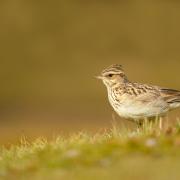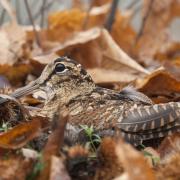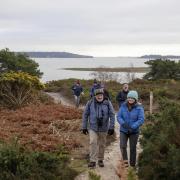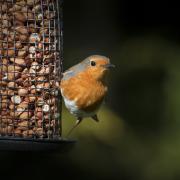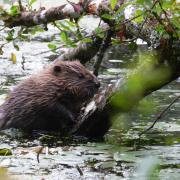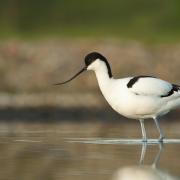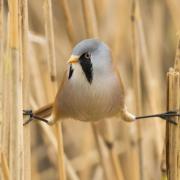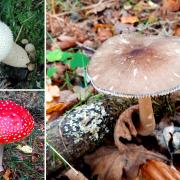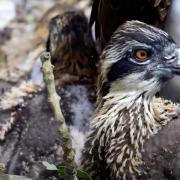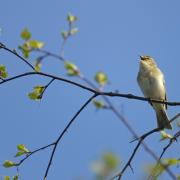From the churring call of the nightjar to colourful moths drawn to night-scented plants, there is plenty of wildlife to look and listen for after sunset Words: Catherine Bolado

The Nocturnal Nightjar
These birds are some of the strangest migrant visitors to the UK. Perfectly camouflaged to look like a fallen log, they only take to the wing at night to catch moths and other insects in their wide mouths. Their distinctive churring call has been likened to a distant engine turning over. Old English folklore believed that this unearthly call was the sound of witches hiding in the bushes.
Nightjars arrive on our shores in spring after wintering in Africa. They nest on the ground from May on heathland and open woodland sites. Their numbers declined by 50% from 1972 to 1992 due to habitat loss, so Dorset, with its range of heathland, is an important site for these intriguing birds.
Where to see them: Tadnoll Heath Nature Reserve- Take the circular walk around the site to hear the nightjars without impacting them. Arrive before dusk and choose a spot, sticking to footpaths so as not to disturb the birds (leave any four-legged friends at home). You will probably hear their 'churring' call before you see them, or you may hear the clap of their wings as they try and attract a mate. At dusk look out for their jerky flight across the sky.

Magnificent Moths
Night-scented plants like honeysuckle, summer jasmine, evening primrose and Nicotiana provide food for moths. So gardens are important fuelling stops for more than 800 strictly nocturnal UK moths. Some plants also provide food for moth caterpillars, and cover for the snoozing adults during the day.
The most spectacular night-flying moths are hawk-moths, which can have wing spans up to 12cm such as the privet hawk-moth. Many adults do not feed, their aim is to find a mate, like the stunning green-scalloped patterned lime hawk-moth or the poplar hawk-moth.
Where to see them: Look for them by night-scented plants after sunset, or join one of Dorset Wildlife Trust's moth trap surveys.
8 August: Moth Trap & Walk on Upton Heath
Bob and Barbara Steedman will open the moth trap at Beacon Hill and see what the night has brought it and then there will be a guided walk on the heath. Runs 9 - 11am. Meet at Beacon Hill Lane, Corfe Mullen, BH21 3RX.

Glorious glow-worms
Sometimes called 'fireflies' these are actually beetles. The males look like a typical beetle but the female adults have no wings and look similar to their larvae. The females produce a glowing greeny-orange light from their bottoms at night by the process of bioluminescence. They climb up plant stems and glow in order to attract males, who have large, photosensitive eyes - perfect for scanning vegetation at night. The larvae can also emit light, and so can the eggs. Adults are only around for a short period in June and July.
The larvae of glow-worms are ferocious predators, mainly feeding on slugs and snails. They kill their prey by delivering a series of toxic bites, injecting digestive proteins that paralyse and eventually dissolve the soft body. While the glow-worm is waiting for this process to happen, it might ride on the snail's back, keeping away from the sticky mucus it produces until dinner is ready!
Where to see them: On chalk and limestone grassland such as Fontmell Down Nature Reserve and Upton Heath Nature Reserve.
Brilliant Bats
Bats are a key indicator of the health of an ecosystem. The good news for bat fans is that Dorset is home to 16 of the 18 UK species, this includes rarities like Bechstein's bat and the grey long-eared bat.
Bechstein's bat colonies are found in woodland. At this time of year females are in maternity colonies of between 10-30 females and pups. They emerge about 30 minutes after sunset and, like all UK bats, feed on midges, moths and other flying insects using echo-location. They also eat arthropods and will often crawl around on the ground to catch them.
Grey long-eared bats roll their very large ears into a ram's horn shape when at rest. They are one of the rarest mammals in the UK. Dorset Wildlife Trust are currently trying to discover more roosts of this rare bat, so if you know of any, please do let them know.
Where to see them: Powerstock Common Nature Reserve and Kilwood Nature Reserve
3 August: Bat Walk in Blandford Forum.Join local bat expert Chris Dieck for this guided walk around Stour Meadow. Meet at Stour Meadows car park, runs 8.30 - 10.30pm. Booking essential on 01258 880699.
For details of all these DWT events and more visit dorsetwildlifetrust.org.uk.








